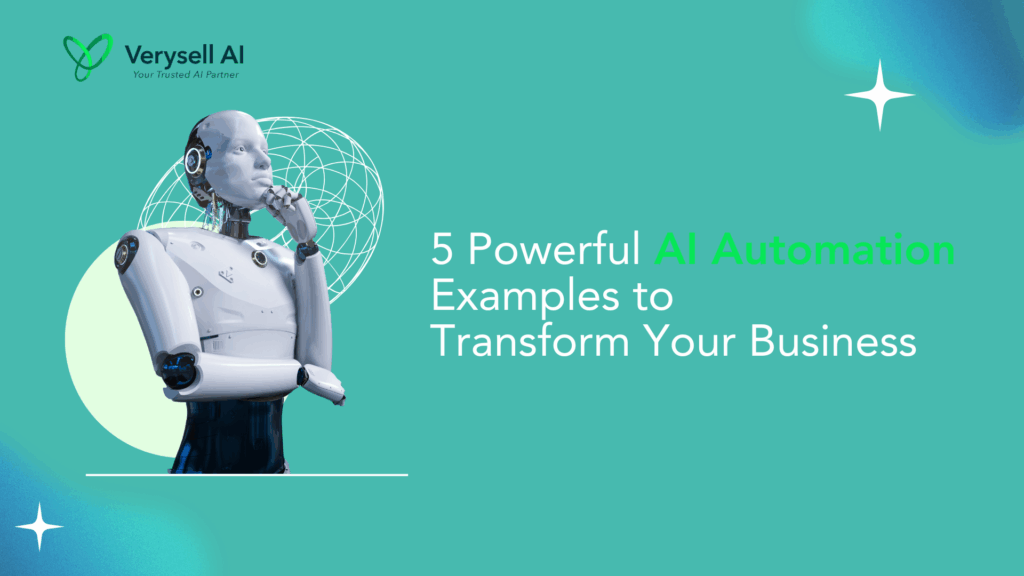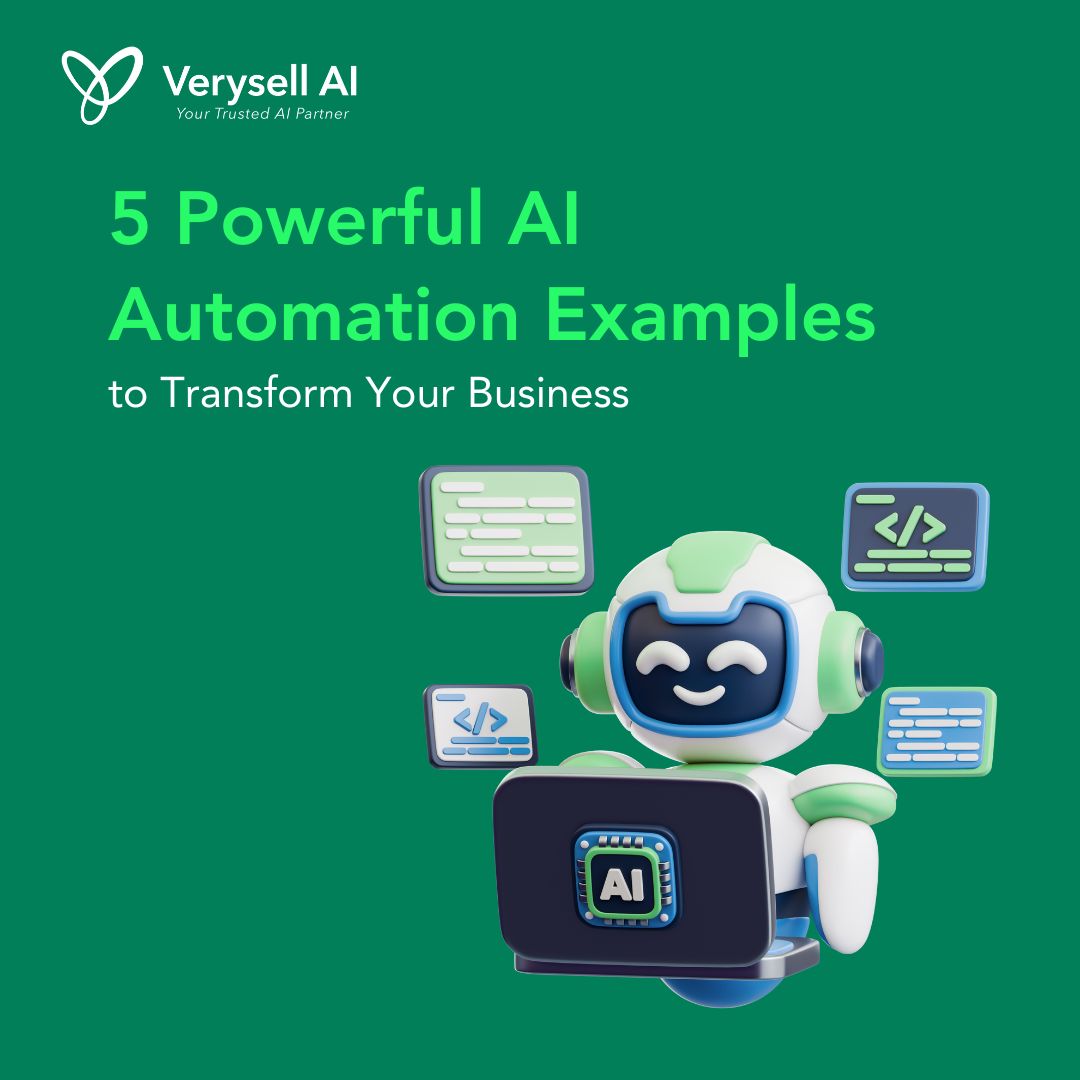AI automation with 5 practical examples to transform your business: In today’s competitive business landscape, leveraging technology isn’t optional when it’s imperative. That’s why AI automation leads the agenda as a transformative force enabling companies to streamline operations, elevate productivity, and deliver superior experiences.
>> Click here to explore our top AI use cases!

AI is transforming the way businesses operate by enabling smarter, more efficient processes. By leveraging AI automation, organizations can unlock new levels of efficiency and innovation, paving the way for sustainable growth. Discover top 5 practical AI automation examples you can implement today to streamline workflows, boost productivity, and reduce costs to gain a competitive edge.
1. AI Automation for Customer Support and Engagement
AI use case: Deploying conversational agents (chatbots/voice bots) and automated routing to respond to customer inquiries, guide users, capture leads and handle routine issues (Williams, 2025). This technology enables faster response times, 24/7 availability, and consistency of service while freeing human agents for higher-value tasks. For example, businesses use chatbots to respond to FAQs and route complex issues to human staff.
Relevant AI solutions from Verysell AI: VeryChat

Key consideration:
When implementing AI automation in customer service, several key considerations must be taken into account (Salesforce, 2025). The benefits include improved response speed and enhanced customer satisfaction, as well as a reduced workload for first-line staff, allowing them to focus on more complex inquiries. Additionally, AI can facilitate valuable data collection on common customer issues, which can inform future improvements.
However, these advantages come with trade-offs. Designing the bot’s logic and escalation rules requires significant upfront effort and ongoing refinement to ensure effectiveness. There’s also a risk of customer frustration if the bot fails to handle requests adequately and the hand-off business process automation with AI is poorly managed. Furthermore, it’s crucial to ensure that conversational AI remains aligned with the company’s tone, brand identity, and privacy requirements, to maintain trust and engagement with customers.
2. Finance and Accounting Process Automation
AI use case: Using AI tools for productivity to automate invoice processing, expense approvals, fraud detection, and financial data extraction. These are high-volume, rule-based tasks that lend themselves to automation and then improvement via learning systems. For example, one article shows how AI helps identify patterns in financial data, optimise spending and create better budget (Mazrouei, 2024).
Relevant AI solutions from Verysell AI: VERA
Key considerations:
Implementing AI in financial processes offers several significant benefits, including faster cycle times for payment runs and approvals, which can enhance overall operational efficiency (Pazouki et al., 2025). Additionally, it reduces manual errors and compliance exposure, leading to more reliable financial practices. Improved visibility into costs and spending patterns further allows organizations to make informed decisions and optimize their financial strategies.

However, these benefits come with trade-offs that need careful consideration. Data quality and system integration are critical; poor input can lead to adverse outcomes. Moreover, while automation can streamline processes, it often requires standardization and change management within finance teams to be effective. There is also the risk of over-automation, where some exceptions still necessitate human judgment, underscoring the importance of maintaining a balanced approach to AI implementation in finance.
3. Recruitment, Onboarding & HR Automation
AI use case: Automating candidate screening, interview scheduling, onboarding workflows, frequently asked questions for new employees. HR departments often perform repeatable tasks such as logging new hires, assigning access, sending documentation that can be streamlined via workflow automation examples.

Relevant AI solutions from Verysell AI: Pariso
The integration of AI in the recruitment process brings several key benefits, such as a more efficient recruiting cycle and an improved candidate experience. By automating initial screening and administrative tasks, organizations can expedite the hiring process, allowing new employees to ramp up more quickly. This efficiency enables HR teams to redirect their focus from mundane paperwork to more strategic initiatives that enhance overall company performance and employee engagement.
However, these advantages are accompanied by important trade-offs that must be addressed. One significant concern is the potential for bias in AI screening if not properly governed, which can undermine the fairness of the recruitment process. Additionally, effective automation requires collaboration across various departments, including IT, facilities, and HR, to ensure a seamless end-to-end experience.
4. Predictive Maintenance & Supply Chain Optimisation
AI use case: Using AI to monitor equipment health, predict failures, optimise maintenance schedules, optimise inventory and logistics workflows. In manufacturing, logistics and heavy-capacity operations, downtime is costly. AI can analyse sensor data, historical events and external factors to anticipate issues and automate corrective workflows (Canary, 2024).

Key considerations:
Implementing AI in asset management offers numerous benefits, including reduced unplanned downtime and the associated costs, which can significantly enhance operational efficiency (Etukudoh and Igunma, 2025). Improved asset lifespan and reliability are additional advantages, as predictive maintenance powered by AI can identify potential issues before they escalate into costly failures (Benhanifia et al., 2025). Furthermore, AI contributes to better supply-chain responsiveness and optimized inventory levels, allowing organizations to respond more effectively to market demands.
However, these benefits come with certain trade-offs that organizations must navigate. Access to robust sensor and data infrastructure, along with comprehensive historical records, is essential for maximizing AI’s effectiveness; without this foundation, the outcomes can be compromised (Nabeel, 2024). Additionally, integrating AI insights with existing operational systems and maintenance workflows can present challenges, requiring careful planning and execution (Takyar, 2025). Lastly, fostering a culture that embraces data-driven recommendations may necessitate a shift in mindset among operations teams, as trust in AI insights is crucial for achieving the intended improvements in efficiency and reliability.
5. Business Process Automation with AI (End-to-End Workflow)
AI use case: Automating entire business-process workflows from customer onboarding, document verification, cross-department approvals, to closing the loop by combining robotic process automation (RPA) with AI decision logic. This approach enables organisations to transform slow, manual, cross-functional workflows into efficient digital pathways. An explicit example: automating the onboarding process for customers including document ingestion and verification (Dilmegani, 2025).

Key considerations:
Leveraging automation in workflow management provides significant benefits, including streamlined workflows that result in fewer hand-offs and delays, ultimately enhancing operational efficiency (Sundari et al., 2024). With end-to-end visibility, organizations can also reduce the risk of errors or data loss, ensuring that processes are more reliable and transparent. Additionally, once established, automated workflows can scale effectively, accommodating high volumes of work with minimal incremental costs, which can lead to substantial savings over time.
However, these advantages come with notable trade-offs that must be carefully considered. Orchestrating automation across various systems, departments, and technologies can be complex and requires meticulous planning. Moreover, successful implementation demands governance, process redesign, and change management, rather than merely a “plug-and-play” approach. There’s also the risk of over-dependence on automation, which can reduce flexibility; certain exceptions will still require human oversight to ensure that unique situations are handled appropriately, preserving the quality of outcomes.
Future of Applying AI Automation for Your Business
For companies looking to harness the value of technology, deploying AI automation offers a clear route to transformation. From automating customer support to streamlining complex business-process flows, these use cases show how organisations can leverage AI use cases for companies, AI tools for productivity, workflow automation examples, and business process automation with AI.
However, achieving value isn’t simply a matter of selecting a tool and flipping a switch. It requires thoughtful selection of use cases, sound data foundations, careful change management, human-in-the-loop design and governance. With those pieces in place, the payoff can be substantial: faster, smarter, more scalable operations. Contact us to explore how we help your business transform AI automation!


